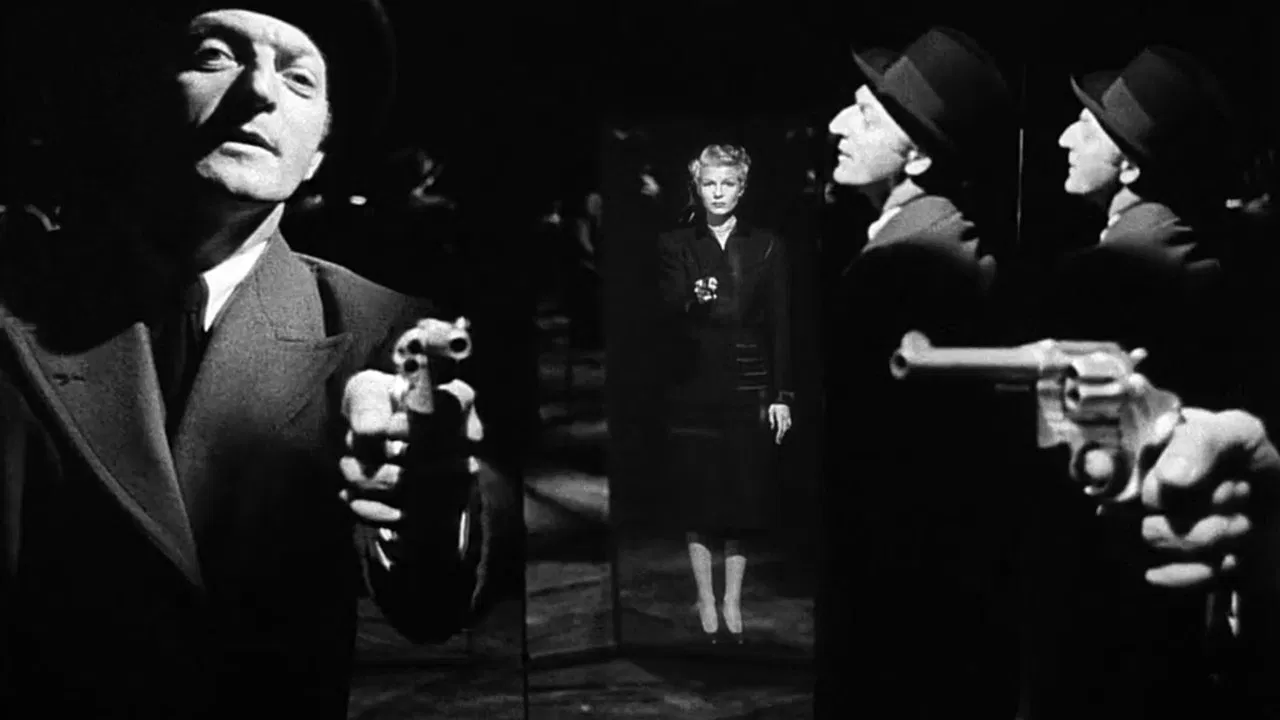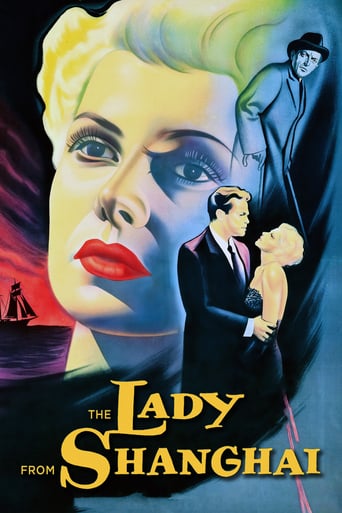

What a fascinating movie, but much of the fascination comes from what it could have been.Sailor, Mike O'Hara (Orson Welles), enters into a strange relationship with the wealthy Bannisters. When crippled Arthur Bannister (Everett Sloane) perversely entices the virile O'Hara with his beautiful wife Elsa (Rita Hayworth), the film has echoes of the three-way relationship in "Gilda" and also with Roman Polanski's much later "Bitter Moon". Critics pounced on the disjointed story and nobody liked what Orsen did to Rita's hair.Welles himself hated the early sequence where Mike saves Elsa from muggers feeling that it was typical B grade action. Of course his main criticism was that others chopped the thing around and ruined it. However I think a couple of other things undermined it and they were all Welles' doing - and nothing to do with Rita's blonde perm.From the beginning Welles comes at us with a dodgy, Hollywood Irish accent, proving that the only people who should do Irish accents are the Irish. He also delivers narration that feels tacked on - did it need narration? And the over-the-top murder plot wouldn't have passed muster on an old episode of "Murder She Wrote".But it's the brilliant look of the film that saves it with set pieces rivalling anything in film noir. Then there is Rita. This was at the time that Welles' marriage to Rita Hayworth was ending - was that finale as he walks away art imitating life? It was suggested that the reason Welles fooled with her hair was to ruin her career (it's on the blurb on the back of my DVD), but that doesn't ring true. In an interview with Peter Bogdanovich, he said how good he thought she was in the role. Rita herself thought it one of the best things she ever did. If anything the film is a valentine to her - even if that wasn't intended. The film reinforces the fact that Rita Hayworth was simply one of the most breathtaking stars ever. Even if her movies aren't hitting the cinemas these days, we can still see clips of her magic on the Internet dancing "The Shorty George" with Fred Astaire or years later flicking her scarf in Frank Sinatra's face in "Pal Joey". In "Lady from Shanghai" that magnetism created a femme fatale for the ages. The behind-the-scenes facts and myths add to the mystique of this film - even its flaws are fascinating.
... View MoreLike a lot of Orson Welles directed films, The Lady from Shanghai was a victim of studio meddling leaving it rather choppy. Maybe the executives would had been happier if Welles had not used such a strong Irish accent.Michael O'Hara (Orson Welles) is a tough Irish seaman who saves sultry Elsa Bannister (Rita Hayworth) in New York when she is hassled by some hoodlums and immediately falls for her.Elsa's husband is a successful and wealthy criminal lawyer, Arthur Bannister (Everett Sloane) who is also disabled and rather bitter. However he gives Michael a job in their yacht as they sail down to Mexico.Things take a sinister turn when Bannister's partner, George Grisby (Glenn Anders) proposes that Michael kill him for $5000 in a plot to fake his own death. As there would be no body, Michael could not be convicted of murder however it is all a convoluted set up which will end up with Michael being defended by Arthur Bannister even though he had an affair with his wife.Welles makes sure his then wife Hayworth is beautiful and glamorous. This film noir is rather off beat and strange at times with a climax in a hall of mirrors which has bee copied many times since. Unusually for a film noir there is a lot of location shooting such as San Francisco and Acapulco.It is still an enjoyable if flawed film, Welles at the time always made interesting films.
... View MoreI just saw this movie in Yugoslav Film Archive. It's really great to watch classics on big screen. I recommend that to all Welles' fans. There is not much to be said about ''The Lady from Shangai''. During the '40s and '50s a lot of film-noir (mystery, detectives...) movies were made. Although film-noir crime movies rarely have 'deeper' philosophical meaning/intellectual importance, some of them are very good. ''The Lady from Shangai'' is certainly one of those. An interesting, original, maybe even unique plot; beautiful Rita Hayworth (I heard that this is her only movie where she was blonde) and magnificent Orson Welles (it is unbelievable how easily this man can change his voice); great visual beauty of the movie; some good dialogues - those are the good sides of ''The Lady from Shangai''. On the other side, as I already mentioned, movie is not an intellectual master-piece. I must also admit that some things are maybe missing (e.g. the movie is named ''The Lady from Shangai'' and I believe that not enough is said about lady's experiences in this Chinese city). However, my vote is still 10/10 for two reasons:1) Good sides made me really enjoy this movie2) I like WellesMy top 30 for now.
... View MoreThis classic film noir has it all – a tight script, great scenes on location, and the seductive and beautiful Rita Hayworth. Orson Welles is in the role of the guy realizes he's swimming with sharks, but can't stop himself from doing so. Isn't that a common theme in these movies? At Hayworth's urging, he takes a job on her husband's yacht; her husband (Everett Sloane) is a rich, invalid lawyer who is having his wife followed. Things are uneasy from the outset, and then take a turn for the worse when Sloane's partner Grigsby (Glenn Anders) offers him money out of the blue to commit a murder – on himself, Grigsby. Glenn Anders looks like a maniacal Mike Ditka while making this proposition – oh wait, Mike Ditka already looks maniacal, but you get the idea.Rita Hayworth went blonde for this film, which apparently led to the ire of her fans, but she's a knockout and on top of it, she delivers a strong performance. I'm not sure about Orson Welles' Irish accent, but he did give us a great film, and it really was his baby, having written the screenplay, produced, directed, and starred in it opposite Hayworth, his wife of four years who he would divorce shortly after the film's release. The film has great scenes in San Francisco and Acapulco, the 'open air' feel of which provide an interesting counterpoint to the 'noir' plot. There is also, of course, the iconic final sequence in the hall of mirrors. The film is successful but it's too bad Welles wasn't given full creative control, as a great deal of that last sequence was edited out and destroyed, which is a real shame. One reason I like it is because despite some intricacies in the plot which will keep you guessing, it's all explained logically in the end. Another is Welles' direction, which is intelligent and provides interesting camera angles. I'm not sure why this movie was released to mixed reviews in 1947, but it's worth seeing if you like films in this genre.
... View More